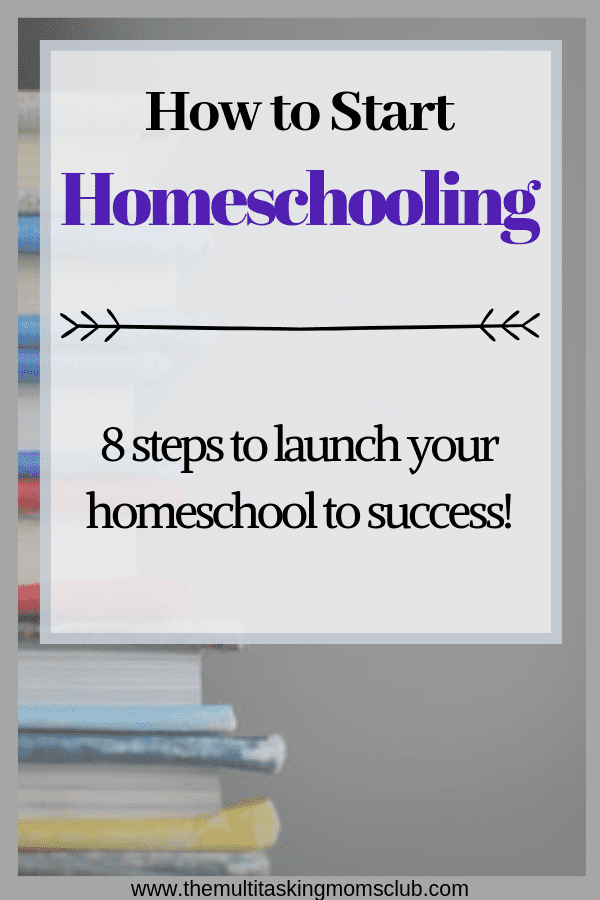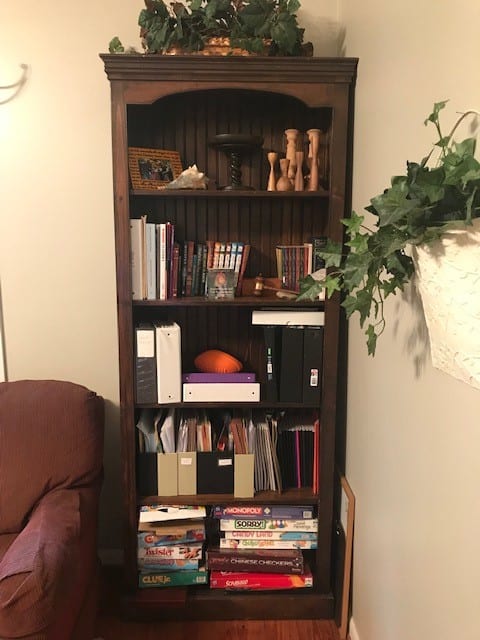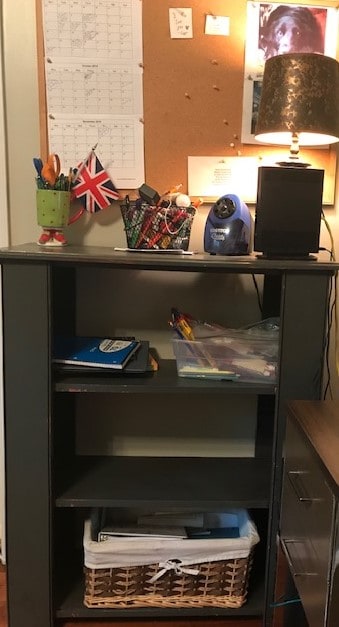Making the decision to start homeschooling is no small feat! If you are new to this journey, Congratulations! Now the fun begins! Here is a simple 8 step plan to show you how to homeschool.

This post may contain affiliate links. Please see my Disclosure Page for details. As an Amazon Associate I earn from qualifying purchases.
Step 1: Make Your Homeschool Legal
Homeschooling is legal in all 50 of the United States (and in numerous other countries), but every state has its own laws. The quickest way to find out the requirements for your state is to visit the Homeschool State Laws website. Laws and requirements can vary wildly from one state to another!
If you are removing your child from a brick and mortar school, public or private, be sure to formally withdraw them. Otherwise, you may find you’ve run afoul of local truancy laws.
Tip: Since every state is different, don’t rely on what your friend or family member in another state is doing. Also, public and private schools are generally not good sources of information about homeschool laws. I still hear stories of new homeschoolers who were misled by school office staff and administrators about various requirements.
Step 2: Deschool
Deschooling is a period of time when you and your child (or children) adjust to being home and learning together. During this time you hold off on formal academics.
Instead, get used to getting up in the morning and eating breakfast together – adjust to not having to rush around first thing. Visit the library, check out books, and read together on the sofa or porch. Go to the park, take field trips, and go on nature walks.
Homeschooling is a lifestyle that can be so totally different from anything you have experienced in the past. It is a lifestyle of learning through everyday life and is not dependant on a classroom or rigid compartmentalization.
Deschooling gives you time to let go of old habits and start new ones.
Tip: The general rule of thumb is to deschool one month for every year the child has been in school. For example, if you pull your 3rd grader from public school, you should plan to deschool for 3 months. This is not a hard and fast rule, though. If you pull your child from school (regardless of grade) in November, you could just deschool till after the holidays. You be the judge.
For more information about deschooling, I recommend reading The Homeschool Mom blog. They offer a wealth of information about deschooling.
Step 3: Read, Read, Read
Before you start homeschooling, take the deschooling time as a parent to read as much as you can about homeschooling. The more you know, the more comfortable you will be.
Well… let’s stop right here. Actually there is the possibility that reading too much may confuse you even more!
Instead, think about your own main concerns about homeschooling. Is it routine and scheduling that worry you? Curriculum or learning styles? Organization and record-keeping? Homeschooling methods? Pick one or two concerns to focus on and read all you can about those things.
Tip: The internet is a goldmine of information about homeschooling! Google is your friend. Also, there have been many great books written about homeschooling that I whole-heartedly recommend:
The Way They Learn by Cynthia Tobias (determining how your child learns best)
The Call of the Wild and Free: Reclaiming Wonder in Your Child’s Education by Ainsley Arment (rethinking your idea of education)
The Well-Educated Mind: A Guide to the Classical Education You Never Had, Updated and Expanded by Susan Wise Bauer (introduction to the Classical homeschooling method)
The Homeschooling Handbook by Mary Griffith (a little bit about everything)
Step 4: Find Your Local Tribe
You could venture forth and homeschool alone, but why? As long as you are not in the Alaskan wilderness or homeschooling from a sailboat, you should be able to find other homeschoolers nearby.
One of the best places to find local homeschool groups is on Facebook. Search for “homeschool” and the name of your town or county.
My own mid-sized city has several homeschooling group pages on Facebook that let me know about get-togethers, co-ops, group field trips, and more. We even discuss curricula and share ideas and concerns.
Tip – Other places you can find homeschoolers:
Churches – many churches have homeschool get-togethers weekly or they offer homeschool classes like PE
The Park – the odds of finding homeschoolers at a park during the school day are high
Libraries – many libraries offer programs for homeschoolers during the day
Community Centers – my daughter has met other homeschoolers while participating in community theater
Community Sports – my son played baseball and basketball for years and there were almost always other homeschoolers around
Step 5: Find Curriculum
Once you’ve learned a bit more about homeschooling, have somewhat determined your child’s learning style, and have begun to formulate an idea of what your own homeschool will look like, it is time to find curriculum.
Warning: it is really, REALLY easy to get completely lost in the curriculum matrix! There are just so, so, so many different options out there and what works best for one child might not work for yours.
I recommend just starting with the basics: reading, writing, and arithmetic. Focusing first on just the fundamentals helps you and your child get a better handle on how they learn, how you teach, and what works best for all of you.
You can add in science, literature, and history later. Or, you can just read together about those subjects without using a formal curriculum.
Tip: Don’t spend too much money upfront, unless you are just rolling in dough and have a ton of disposable income. I have seen too many families start homeschooling, buy a pricey all-in-one boxed curriculum, then discover they all hate it. At that point, they feel like they have to finish what they bought because they spent so much money on it. It is a sure-fire way to start your homeschooling journey off on the wrong foot.
To see my top picks for basic homeschool curriculum, check out these posts:
The Best Homeschool Curriculum for Elementary School
The Best Homeschool Curriculum for Middle School
Step 6: Pick a Start Date and Plan a Schedule
It’s time to start homeschooling! Make a big deal out of the first day! After deschooling, you want to make sure that your first day is special. Make it the first day of the rest of your lives!
Have a start time, plan a fun activity, do a crazy experiment, have a special lunch planned. Make it exciting!
Will the excitement last? Probably not. Just speaking the truth here, folks. There will be humdrum days in your future, but don’t let the first day be humdrum.
Make a schedule and stick to it from day one. It is much more difficult to get kids to stick to a schedule if you throw it at them after a month of homeschooling. At that point, they have already established their habits and those habits can be hard to break.
Tip: As much as I recommend establishing a routine and schedule from day one, don’t be afraid to tweak that routine as you go. Once you get started, you may find that you need to spend less time on Math and more on Writing. You may find that one child needs more one-on-one teaching. Go with the flow and adjust where and when necessary.
Step 7: Create an Organization System
Though I tend toward a more minimalist homeschool in my house, there is still a lot of “stuff” to be organized. Whether you have a homeschool room or not, you still need to organize your curriculum books, teacher’s manuals, school supplies, work to be done, and work to be turned in.
Before you start homeschooling, I recommend having a designated shelf or basket for each child. Make it easy for your children to find what they need to start each day.
For myself, I’m a big fan of 3-ringed binders. I keep all my homeschool plans, important papers (Declaration of Intent, standardized test scores), and samples of the kids’ work in these binders.
Tip: To minimize clutter, devote one bookshelf to homeschooling material. If that bookshelf starts to overflow, it’s time to purge. Here is a picture of our homeschool bookshelf with board games on the bottom, school supplies on the second shelf, my 3-ringed binders on the third shelf, and books on the fourth:

I also keep a second bookshelf by the computer with extra art supplies, a pencil sharpener, a basket of extra miscellaneous supplies, and, notice, there is still room to grow:

Step 8: Breathe
You got this! When you start homeschooling, you may lose sleep thinking you are going to totally mess up your children for life. Truth bomb: that is highly unlikely.
Your time and attention alone will do wonders for their development academically, as well as mentally, spiritually, and emotionally. Those are really the most important elements of a healthy adult. Adding in the actual academic lessons will just be the icing on the cake.
If you find you need help with academics, find a co-op or online class to fill the gap.
If you worry about their socialization, get them out and about in town.
If you are overwhelmed and need a week off, take a week off. Let the kids just read books or watch documentaries or educational TV shows.
If your child seems to be behind in reading, don’t panic. Just keep plugging away a little every day and they will get it eventually. If in doubt, have them tested for learning differences.
Basically, just breathe. There will be bad days. Breathe. They will hit puberty and turn into foreigners in your own home. Breathe. They (and you) will be unsure of their future plans and you will have no idea what path you are aiming for. Breathe. What seemed to work last year, suddenly won’t work this year. Breathe.
All that will pass. You will make adjustments and you will move on. Most of all, your children (and you) will have grown exponentially because you decided to make the leap to homeschooling.
Be sure to check out these posts from Homeschooling:
How to Homeschool for Free (or on the Cheap!)
Why I Don’t Give My Homeschooled High Schoolers Tests (and What We Do Instead)
What Does a Relaxed Homeschool High School Look Like?
4 Things I Wish I Had Known Before I Started Homeschooling
